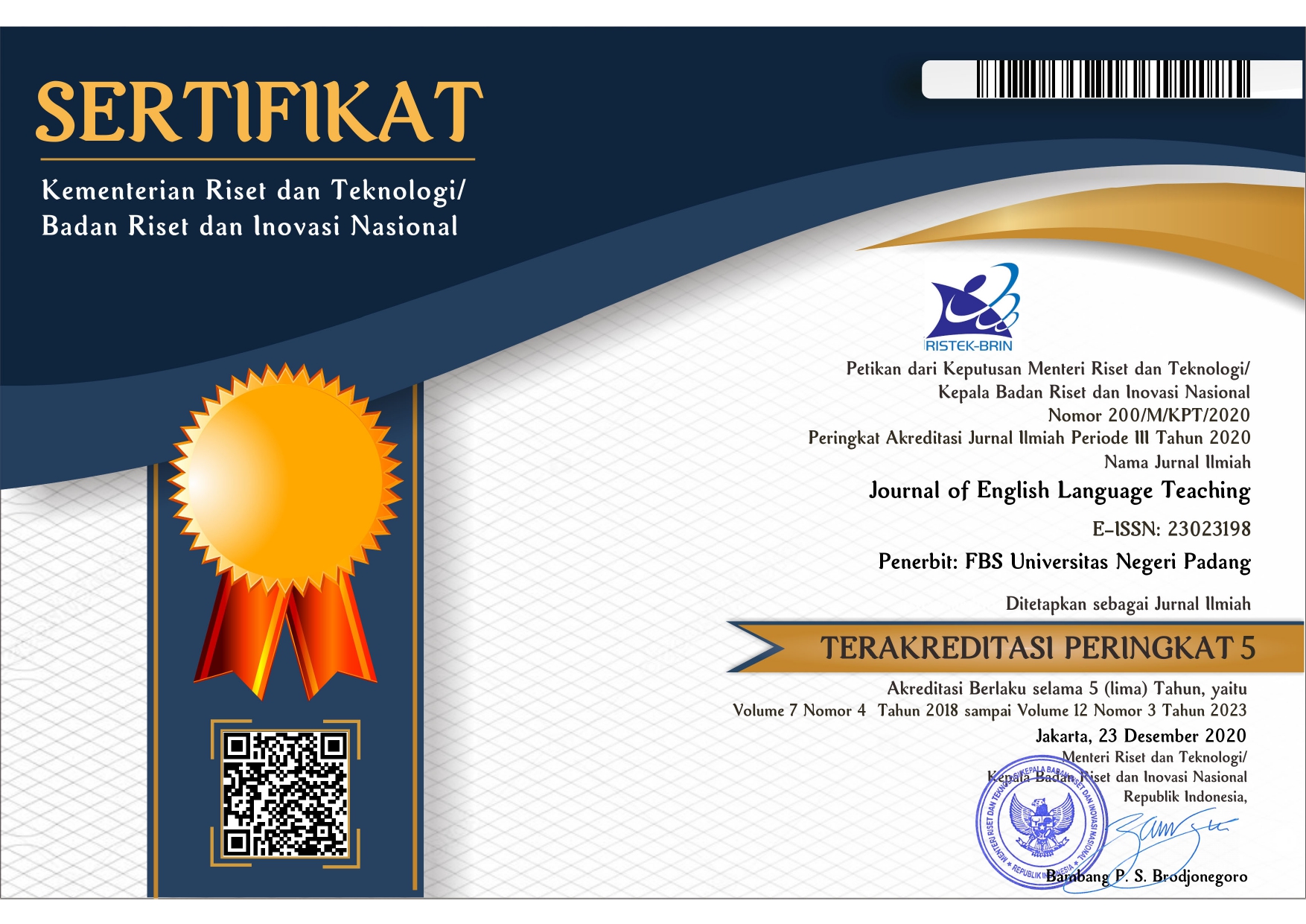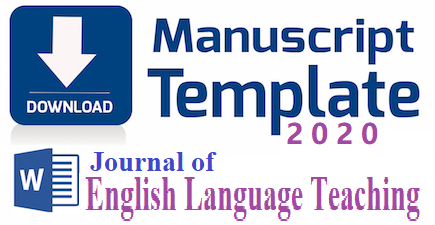USING SONGS TO TEACH ENGLISH TO YOUNG LEARNERS
 ), An Fauzia Rozani Syafei(2),
), An Fauzia Rozani Syafei(2), (1) English Department Faculty of Languages and Arts State University of Padang
(2) English Department Faculty of Languages and Arts State University of Padang
 Corresponding Author
Corresponding Author
Copyright (c) 2017 Journal of English Language Teaching
DOI : https://doi.org/10.24036/jelt.v5i1.7310
Full Text:
 Language : en
Language : en
Abstract
This paper explains about the implementation of using songs to teach English to young learners. The songs that can be used are popular songs for young learners. At the beginning of the activity, teacher introduces the lyrics that will be sung. The lyrics of the song should be compared with the topic. The activity of singing a song can be followed by another activities which the activities can improve their confidence. There are some advantages in teaching English through songs like various activities in the classroom, fun, and alive, also the young learners be active and confidence. Then, songs can improve the young learner’s skill in memorizing new words and pronouncing clearly. Using songs as the activity in teaching English help the teacher to build an active and interesting class.
Keywords
References
Anderson, Richard C. (1973). Educational Psychology. New York: Harper and Row.
Bailey, Kathleen M. (2005). Practical English Language Teaching Speaking. New York: Mc Graw Hill.
Brown, H. D. (1987). Principles of Language Learning and Teaching (2nd Ed.). New Jersey: Prentice Hall.
Brown, H. D. (2001). Teaching by Principles: An Interactive Approach to Language Pedagogy (2nd Ed.). New York: Addison Wesley Longman, Inc.
Brown, H. D. (2007). Principles of Language Learning and Teaching. (5th Ed). New York: Pearson Education, Inc.
Brumfit. (1997). Young Learners Characteristics (TEYL/TMYL). (Online) Accessed on March 1th, 2016.
Cameron, Lynne. (2001). Teaching Languages to Young Learners. United Kingdom: Cambridge University Press
Curtain and Pesola. (1994). Languages and Children. (2nd Ed). New York: Addison Wesley Longman, Inc.
David, McClelland M, John W. Atkinson, Russel A. Clark, Edgar L.
Lowel. (1976). The Achievement Motive. New York: Irvington Press.
Hudelson, Sarah. (1991). EFL Teaching and Children: A Topic-Based Approach (The English Teaching Forum). Arizona State University, USA.
Nanda & Don, N. 2012. Improving Student's Speaking Ability through Western Song at Junior High School. Journal of English Language Teaching, 1 (1) Serie B.
http://peni.staff.uns.ac.id/2008/10/10/young -learner-characteristics/ Accessed on June 3rd, 2015)
http://anfauziasyafei.blogspot.com/2015_01_01_achieve.html. Accessed on March 8th, 2015.
http://mengajarenglish.com/2013/03/29/using-more-english-in-class/. Accessed on March 1st, 2016.
http://www.5minuteenglish.com/why-learn-english.htm. Accessed on March 1st, 2016.
Jolly, Y. S. (1975). The use of songs in teaching foreign languages. The Modern Language Journal, 59(1/2), 11-14.
http://dx.doi.org/10.2307/325440
Krashen, Stephen D. and Terrell, Tracy D. (1983). The Natural Approach. New Jersey: Alemany Press Regent/Prentice Hall.
Larsen-Freeman, D. (2000). Techniques and Principles in Language Teaching. (2nd Ed.). Oxford: Oxford University Press.
Murphey, T. (1992). Music and song. Oxford, England: Oxford University Press.
Phillips, S. (1993). Young Learners. Oxford, England: Oxford University Press.
Sawrey, James M., et al. (1964). Educational Psychology. United States: Boston.
Smith, Henry P. (1957). Psychology in Teaching. United States: University of Kansas.
Suyanto, K.K.E. (2008). English for Young Learners. Jakarta: Bumi Aksara.
Thornbury, Scott. (2006). How to Teach Speaking. New York: Addison Wesley Longman, Inc.
 Article Metrics
Article Metrics
 Abstract Views : 9427 times
Abstract Views : 9427 times
 PDF Downloaded : 2624 times
PDF Downloaded : 2624 times
Refbacks
- There are currently no refbacks.
Copyright (c) 2017 Journal of English Language Teaching

This work is licensed under a Creative Commons Attribution-NonCommercial-NoDerivatives 4.0 International License.
















